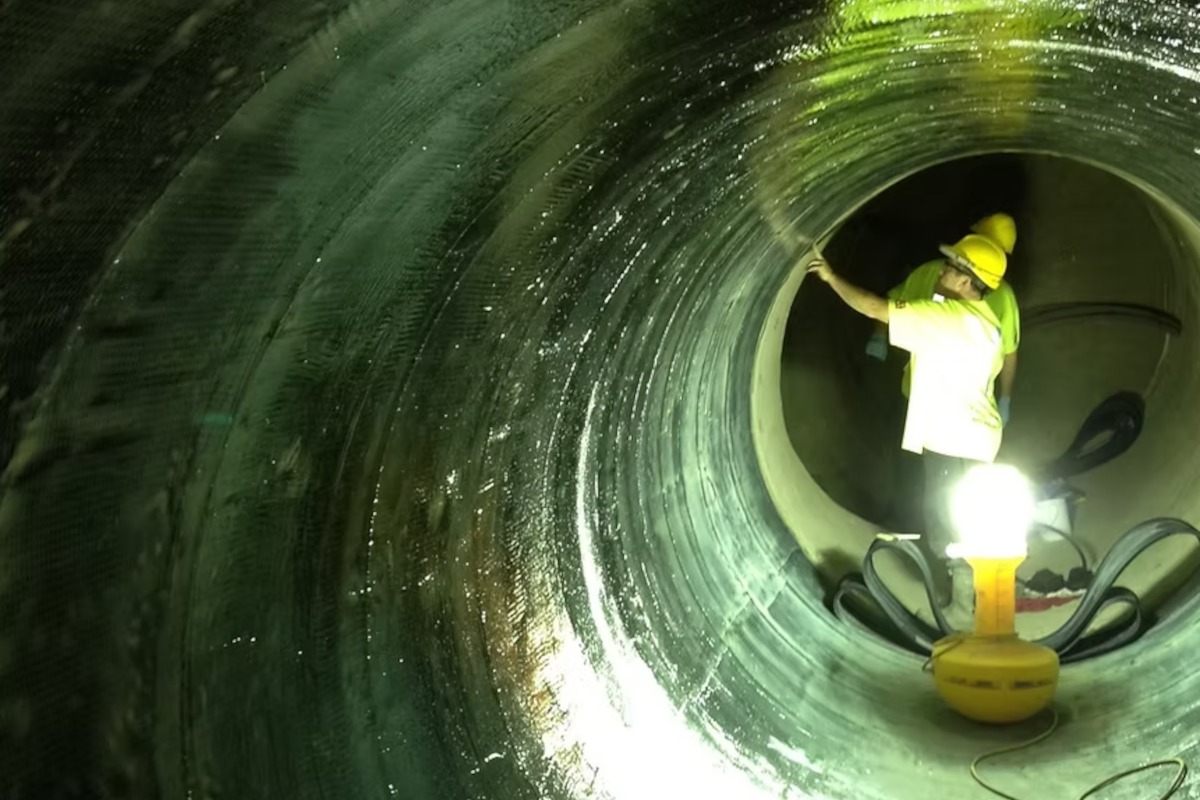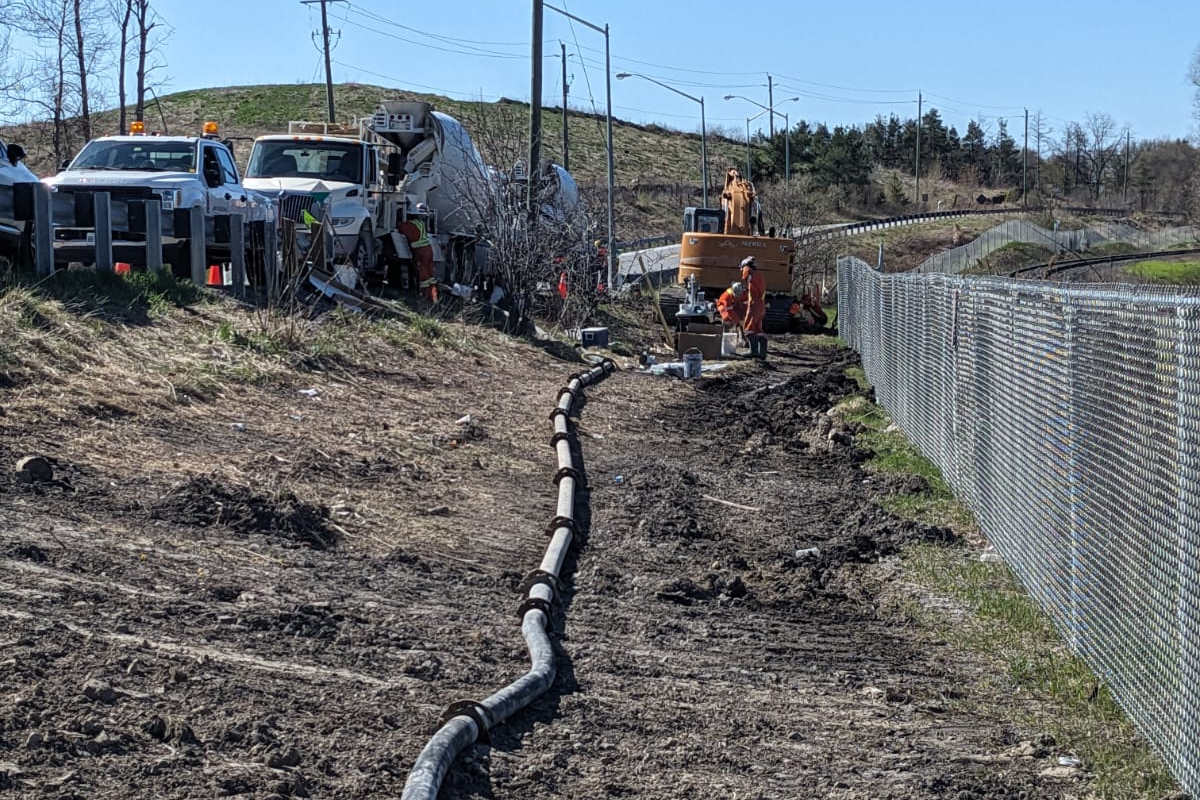
Toronto’s Massive Push for Underground Infrastructure Tests the Durability of Small Boring Units
October 2, 2015

Earth Boring Co. has been utilizing Robbins SBUs since 1997, and many units in their fleet have been used on dozens of projects over kilometers of tunnel.
Toronto, Canada’s aging system of sewers and water mains is a manageable problem — until the mercury dips. Record-low temperatures in the region during the 2015 winter have compounded the problem of water main and other pipeline breaks: about 1,500 per year on average.
The majority of the City’s lines are at least 55 years old, built in the 1950s and 1960s using thin-walled pipes that have corroded badly. The piping is being replaced at a rate of about 50 mi (80 km) per year, but increasing population has also required new utilities to be placed. It is in this booming environment of trenchless installations that the proving ground for various types of trenchless equipment lies.
In answer to the numerous jobs being bid, local contractor Earth Boring Co. Ltd. is utilizing its fleet of Robbins Small Boring Units (SBUs). The hard rock and mixed ground boring attachments owned by the company, ranging from 36 in. (900 mm) to 54 in. (1,370 mm) in diameter, are being used on at least 30 crossings throughout 2015 below highways, major roadways, and other structures.
“Regional municipalities are seeing that they have got to renew this infrastructure, it is a vital part of the city that must be replaced, and it’s obviously helpful for our business. We are seeing steady growth in trenchless work both with SBUs and other methods in this part of Ontario,” said Gene Woodbridge, vice president of Earth Boring.
SBUs on the Move
In 2015 alone, Earth Boring has fielded numerous requests for crossings in many types of hard rock and mixed ground. In May 2015, it conducted side-by-side bores measuring 138 ft (42 m) and 148 ft (45 m) in length below Hurontario Street in the Toronto suburb of Mississauga. The heavily trafficked roadway saw an average of 63,300 cars daily in 2012, and that number has been growing. As such, it was critical that the construction not interrupt the flow of traffic. Earth Boring used a 36-in. (900-mm) SBU-A that had to maintain line and grade as it traveled below an existing storm sewer.

Earth Boring Co. has completed at least 30 crossings in 2015—pictured here, parallel crossings below Hurontario Street, a major thoroughfare.
The new lines would carry water and sewer for recently completed condo buildings, with the final 18-in. concrete pipe installed inside the 36-in. (900-mm) steel casing.
“On the second bore, we had a little bit of a challenge with a mixed face. We were in a zone of bedrock transitioning into clay and till,” said Woodbridge. “We were able to open up the steering pads in the quadrants of the SBU and force it down so the SBU head wouldn’t rise up.”
The bores took five to seven days to complete at an average of 20 ft (6 m) per day, and each holed through on line and grade. “With the SBU head this is seldom an issue, as it won’t grab and push away at the ground. It usually digs right through it,” said Woodbridge.
At the same time that crews carried out bores below Hurontario, a challenging crossing was under way north of Toronto in the town of Newmarket. Two 328-ft (100-m) long bores were required below a protected wetland area in cobbles and clays — due to water inflows some water had to be pumped out of the 16 ft (5 m) deep bore pit. The sanitary sewer bores for a new housing development had to be excavated on line and grade, and required crossing through sandy silt, cobbles, and boulders.
“We bored right through everything. The head crushed it up,” Woodbridge said. The bores took about five weeks to complete at an average of 15 ft (4.6 m) per day.
The latest project for Earth Boring, a series of 22 bores using SBUs below Highway 410, is epic and ongoing. The work is required due to a widening of the roadway, which requires a new stormwater drainage system. The company recently completed a 200-ft (60-m) bore with a 48-in. (1,200-mm) SBU-A and one with a 54-in.(1,370-mm) SBU-A, both in mixed face rock. “We have done about 10 bores so far in shale bedrock with mixed clay material on top. The SBUs are doing a good job with line and grade and we don’t have to worry about encountering boulders below the highway,” said Woodbridge.
He added that any boulders encountered thus far have been bored through without requiring extraction.
More bores are expected throughout 2015, in both mixed ground and hard rock. The company recently completed a bore at the Trenton Canadian Forces Military Base in very hard limestone using a 36-in. (900-mm) SBU-A. While in competent limestone, the machine was able to crush rock at a rates averaging 12 to 15 ft (3.7 to 4.6 m) per day.

Crew members for contractor Earth Boring Co. pause for a rest during the setup of a Robbins SBU-A an Auger Boring Machine in Mississauga, Ontario.
The Business of Boring
Earth Boring, a Mississauga-based contractor, has high praise for SBUs, a method it has been using since 1997. The contractor has been in business for 68 years and owns a fleet of six SBUs, as well as a small diameter tunnel boring machine manufactured by Robbins. Many of its SBUs have been used on dozens of projects and kilometers of tunnel over a period of years. It is this durability that Earth Boring praised the highest.
“We do a lot of work with them. You just put an SBU on the project and you don’t have to worry about what you can go through. Even in solid rock, it just zips right through,” said Woodbridge.
Earth Boring operations manager John Currey agreed. “We’ve had tremendous success with all sizes of our SBUs, even 54-in. (1,370-mm) and 72-in. (1,830-mm) sizes. They walk through the ground as if we are boring through clay or sand.”
The contractor has had steady business using SBUs, and forecasts that the trend will continue to increase, particularly given Toronto’s wide-reaching plans. “This is a huge initiative for both renewal of existing infrastructure and land development for new housing. We are going deeper and bigger than ever before,” said Woodbridge.
As far as he is concerned, the SBU and ABM technology has proven itself on many occasions in the Toronto area. “I’ve always considered auger boring the unsung hero of the trenchless industry. It’s the workhorse that no one ever talks about. We like SBU technology because it came about as an extension of auger boring. It’s not reinventing the wheel, it is based on a tried and true technology.”
Desiree Willis is a technical writer for The Robbins Co.




